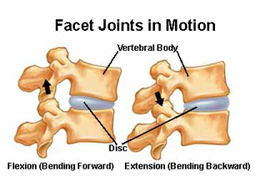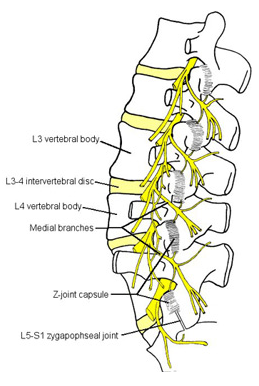Injection therapy
 Is reserved for patients for whom other conservative treatments have not worked. Injections may consist of epidural steroid injections, spinal nerve blocks, or facet joint injections. Steroid injections can decrease inflammation to spinal nerves and thereby reduce the pain. Nerve blocks interrupt the signal of pain from a spinal nerve from reaching your brain. This can provide temporary relief of pain. These injections may also assist in confirming or negating a specific diagnosis regarding your spinal problem. Facet joint injections can provide relief of pain caused by an arthritic spine joint.
Is reserved for patients for whom other conservative treatments have not worked. Injections may consist of epidural steroid injections, spinal nerve blocks, or facet joint injections. Steroid injections can decrease inflammation to spinal nerves and thereby reduce the pain. Nerve blocks interrupt the signal of pain from a spinal nerve from reaching your brain. This can provide temporary relief of pain. These injections may also assist in confirming or negating a specific diagnosis regarding your spinal problem. Facet joint injections can provide relief of pain caused by an arthritic spine joint.
How does a facet joint injection work?
Zygapophseal joint injections are a diagnostic and a potentially therapeutic procedure. Diagnostically, a small amount of local anaesthetic is usually injected into the joint. Pain is usually assessed immediately after the procedure and patients complete a pain chart for later review by their doctor. If there is a resolution or a reduction in the symptoms as compared with the symptoms prior to the procedure, there usually is considered confirmation that the joint injected is producing pain.
 From a therapeutic standpoint, a small amount of corticosteroid is usually injected in addition to the local anaesthetic. Corticosteroids are potent anti-inflammatory medications. Reducing the inflammation in the joint will decrease the amount of joint effusion and therefore decrease distension of the capsule, which will often offer longer lasting pain relief. It is possible that this injection will block the pain long enough to allow the body to begin the process of repairing itself.
From a therapeutic standpoint, a small amount of corticosteroid is usually injected in addition to the local anaesthetic. Corticosteroids are potent anti-inflammatory medications. Reducing the inflammation in the joint will decrease the amount of joint effusion and therefore decrease distension of the capsule, which will often offer longer lasting pain relief. It is possible that this injection will block the pain long enough to allow the body to begin the process of repairing itself.
The chief effect of a Z-joint injection is to reduce pain, but the effect is not always long lasting and differs from person to person. Most patients will receive good relief for some weeks or up to three months after injection, but only a small proportion obtain longer-lasting relief. Some patients do not experience any pain relief and may in fact suffer an increase in pain and/or other symptoms as detailed later. A positive response to facet joint injection is not predictive of a good outcome from surgery.
Your physician will probably request that you participate in physical therapy to optimise the long term effect of the injection while the pain is relieved. Exercise can be employed for strengthening and stabilising the affected area.
Where a good response to facet joint injection has been observed and the pain has recurred, an alternative method of treatment called Medial Branch Ablation can be employed. In this procedure, often undertaken by an anaesthetist, a special probe is introduced into the region of the medial branch nerves (see diagram) and its tip heats up to a temperature sufficient to cauterise the tiny terminal nerve fibrils, effectively making them numb for a period of time. This procedure may produce a similar effect to facet joint injection, however for a longer period. The procedure may also be repeated where a good response was observed for a period of time. Repeated facet joint injection is generally less rewarding.
